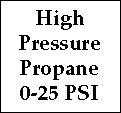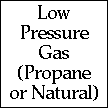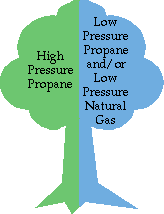The Tree of Knowledge (and which side are you on?)
So what does this tree mean? Well, the tree is suggesting you will have to make a decision as to what type of fuel you will use in your glassmaking studio. The answer will determine a great many issues along the lines of appropriate mixers, heads, safety systems, and even the size and strength of gas pipe used to plumb your studio.
So go to your friendly local gas supplier and settle this issue right in the beginning.
In the old days (say 1970) a person putting up a new shop could pretty much install anything he/she wanted. Now, there are much stricter rules and your gas inspector is the boss in this area of whether or not you can turn on and actually use this facility you are building. He and his friend, the fire marshal, are going to decide (without your consent) whether it is appropriate to have a glass facility in your choice of location (like the old mill building downtown). So check out your facts! Then make a plan and get the plan approved before you buy a single brick.
So here is the first hoop. Make a decision and click on one of the two buttons.
| High pressure propane is generally used in rural situations where electricity is not reliable. High pressure gas is dangerous because if a pipe or hose breaks inside a building, the building could rapidly fill with gas and explode. For this reason it is not often approved in residential areas or in situations where low pressure gas could be used. |
 |
 |
Low pressure gas (propane or natural gas) is the most common type of service for new installations today. With the use of low pressure gas one needs an electric blower and a forced air mixer to properly use the gas. Because of the low pressure (6-8" water column inches) larger pipes are needed to carry an equal amount of fuel to the mixer. |

